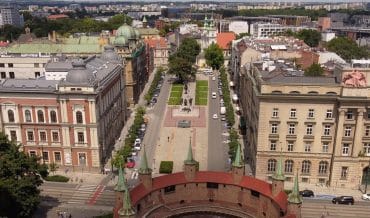Knowledge Base
Kraków is one of Poland’s oldest and most historically important towns. Learn about its rich history and see the cultural landmarks that have helped shape its legacy. When you walk through Kraków’s cobblestone streets, you can feel the city’s past. Kraków, which used to be the capital of Poland, is
Krakow Wiki
- March 22, 2024
The first cabaret in Krakow after the Second World War was the “Siedem kotów” cabaret, whose founders were Marian Eile, Janina Ipohorska and Jerzy Waldorff. The cabaret was located at 1 Zyblikiewicza Street. The first premiere took place in 1946 and was entitled “3 x meow”. Famous Polish actors such
Krakow Wiki
- May 19, 2021
Early Life and Education in Florence Gucci Santi, the distinguished Italian architect and sculptor, was born around 1500 in Florence and died in 1576 in Mirów near Pińczów. He was also known by the name Florentino, while his surname appeared in historical documents with various spellings, including Guci and Guczy,
Krakow Wiki
- May 13, 2021
The Act of the Seym of 1550 allowed the nobility to purchase squares and real estate also in cities. As a result of this act, municipal real estate and suburban estates owned by the nobility or the clergy received judicial and administrative jurisdiction independent of the city, so they were
Krakow Wiki
- April 30, 2021
Key Facts Born in 1842 in Przemyśl, died in 1907 in Kraków Pioneer of physical education in Poland and visionary social reformer Professor of gynecology and obstetrics at the Jagiellonian University from 1895 Founder of Jordana Park in 1887, the first public playground in Poland Studied medicine in Vienna and
Krakow Wiki
- April 28, 2021
Key Facts Born in 1844 in Tomisławice, participated in the January Uprising as a young man Pioneer in gas lighting technology – developed improved gas production methods and established gas plants across multiple US cities Co-founder of Equitable Gas Light Company, which became one of America’s major gas utilities serving
Krakow Wiki
- April 26, 2021
By music historians, Krakow is considered the cradle of Polish jazz. In 1926, the “Jazz” association was established in Krakow. In this city, jazz music has moved from restaurants and cafes to concert halls. In the 1930s at the Władysław Żeleński Music School, jazz music classes were opened, taught by the
Krakow Wiki
- April 26, 2021
Jugowice is a former servant settlement, and now an estate of detached houses within the administrative boundaries of Krakow, it is part of the Swoszowice district. The settlement was incorporated into Krakow in 1941. In the past, the local inhabitants used to produce wooden yokes, plows and harrows.
Krakow Wiki
- April 26, 2021
Key Facts Born in Lviv in 1749, died in Kraków in 1809 Leading Polish mineralogist and chemist during the Enlightenment period Multi-disciplinary scholar: botanist, physician, chemist, and theologian Professor at the Main Crown School (predecessor of Jagiellonian University) Pioneer of Polish coal mining and conducted first hard coal coking experiments
Krakow Wiki
- April 23, 2021
• Born in 1861 in Grzegórzowice, died in 1929 in Kraków • Known by the pseudonym “Manggha” – became synonymous with Japanese art appreciation in Poland • Renowned art critic, patron, and collector who significantly influenced Polish cultural discourse during the Young Poland movement • Assembled one of Europe’s most
Krakow Wiki
- April 23, 2021
